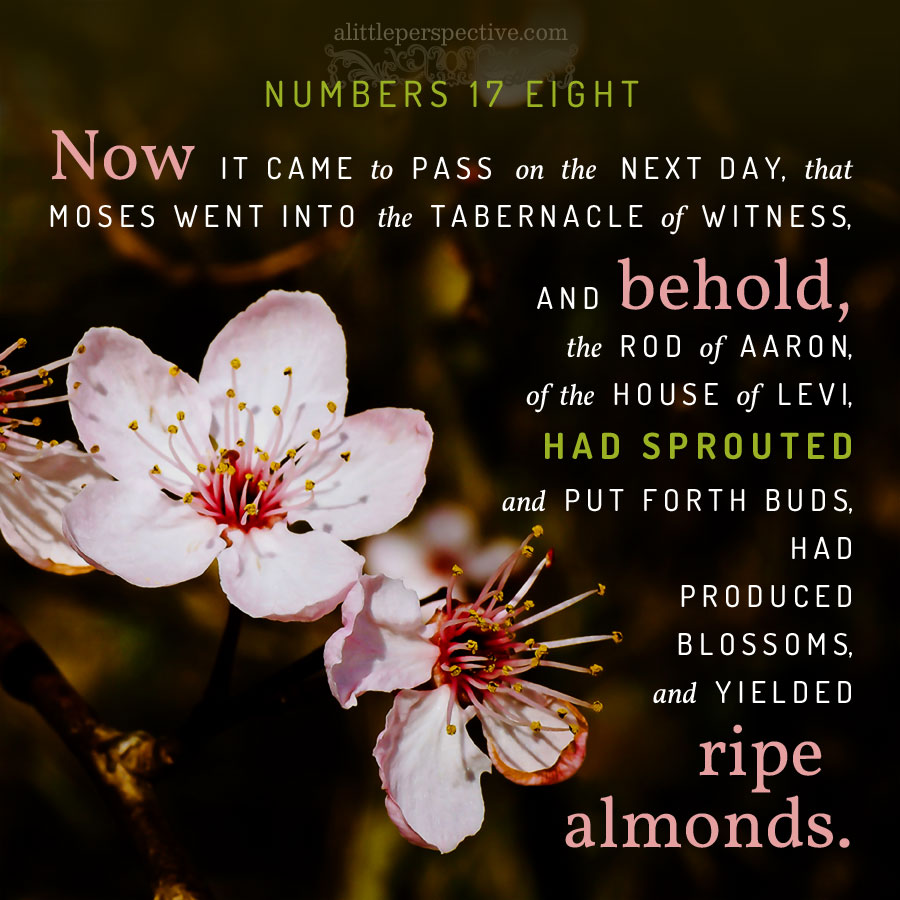Read Numbers 17 and 18 at Bible Gateway.
The Hebrew paragraph divisions for today’s chapters are:
Num 17:1-9 {p} Aaron’s rod budded
Num 17:10-11 {p} Aaron’s rod kept as a memorial before the ark of the covenant
Num 17:12-13 {s} Whoever comes near the tabernacle perishes
Num 18:1-7 {p} Aaron and sons to attend to their priesthood
Num 18:8-20 {s} Aaron and sons’ portions
Num 18:21-24 {p} Levites portion: tithes
Num 18:25-32 {p} Levites to give a tithe of the tithe to Aaron and sons
One of the strong themes in today’s chapters is Num 17:12-13 + Num 18:1-7. This theme makes its own chiastic structure:
Num 17:12-18:7
1a) Num 17:12-13 {s} Whoever comes near must die;
1b) Num 18:1, Aaron + sons to bear iniquity of sanctuary + priesthood;
1c) Num 18:2-4, Levites attend to needs of Aaron and sons + tabernacle;
central axis) Num 18:5, “And you shall attend to the duties of the sanctuary and the duties of the altar, that there may be no more wrath of the children of Israel;”
2c) Num 18:6, Levites a gift to Aaron + sons to do the work of the tabernacle;
2b) Num 18:7, Priesthood a gift to Aaron + sons to attend to priesthood + sanctuary;
2a) Num 18:7b {p} The outsider who comes near shall be put to death.
Now this is interesting. God commands Aaron to attend to his priesthood, so that there may be no more wrath on the children of Israel. Wrath has just been poured out on the children of Israel. Korah and his followers were swallowed alive by the earth, and 250 leaders were consumed by fire from the LORD. 14,000 people of the children of Israel had died of a plague from the LORD. In fact, here is another chiastic structure:
Num 16:1-18:7
1a) Num 16:1-50 {sx3+p+s+p} Wrath came upon the children of Israel (rebellion of leaders + rebellion of the congregation);
central axis) Num 17:1-11 {p+p} Aaron’s rod that budded;
2a) Num 17:12-18:7 {s+p} That no more wrath may come upon the children of Israel.
You know, we have just read some hard chapters. The generation of unbelievers is not going to inherit the promise, and the people who went to war anyway were defeated. The man who gathered sticks on the Sabbath was stoned to death with stones. That was not Israel’s idea or Moses’ idea, that was done at the direction of the LORD.
And then we saw that those events inspired Korah’s rebellion, since these judgments of the Lord were hard. The death of the leaders then inspired the rebellion of the whole congregation, since the judgments of the earth swallowing Korah + the burning of the 250 leaders were hard.
But this chiastic structure reveals to us, that God does not want wrath to come upon the children of Israel. He doesn’t delight in plague or death or destruction. So we see that the whole institution of the tabernacle rites and the priesthood is to prevent wrath from coming on the children of Israel.
And here we find the gospel. For the tabernacle, in its blueprints and design, is a prophetic type proclaiming Messiah. The priesthood, in its rites and responsibilities, is a prophetic type proclaiming Messiah. Messiah is the mediator between God and man, to prevent wrath from coming upon the children of Israel. (That is me and you!) But let us not miss the other side of what Scripture is teaching: those who reject God’s mediator, who is Messiah Yeshua, will partake of wrath — for rebellion, unbelief, and idolatry will receive wrath for itself, in order to destroy it.
That might be hard, but it is true and right and just – and even merciful and loving, because rebellion against God is allegiance to the first rebel, whose entire existence is devoted to our loss, destruction, and death (Joh 10:10).

















You have amazing insights and I really appreciate your website. Wanted to share this morning as I’m preparing for Korah, I see 2 more chiasms in Chapter 16. You may already see these, but I was curious if you see them working together. One goes from Num 16:1 – Num 16:19. Beginning and ending with Korah standing in opposition to Moses and Aaron. The center are the words “to kill us in the wilderness and to lord it over us…” in verse 13B. Another chiasm appears between Num 16:41-50…beginning and ending with Moses and Aaron at the entrance to the tent of meeting and the center being vs 47 “So Aaron did as Moses said, and ran into the midst of the assembly.” These two are right next to each other where Korah unwittingly pronounces a curse on himself followed by his death; the next chiasm shows the danger of the people needing a savior who is Aaron.
Feels like a good start, but I know first impressions can be misleading. Thanks for your attention.
Okay, I think I figured it out. If there is a better way to connect with you than doing comments, please let me know. I really get a lot of value from your thoughts and this website. Thanks so much for all the effort you put into this!
Hello Andrew, I apologize for the delay in replying; we were on vacation at our son and daughter-
-in-law’s when you first posted. Better would be email at alittleperspective@gmail.com, I don’t check it all the time since I rarely get email, but if I knew someone was emailing I would check it more often. Also I am on social media and that gets checked every day. Try Gab @ChristineMiller and MeWe https://mewe.com/join/a_little_perspective.